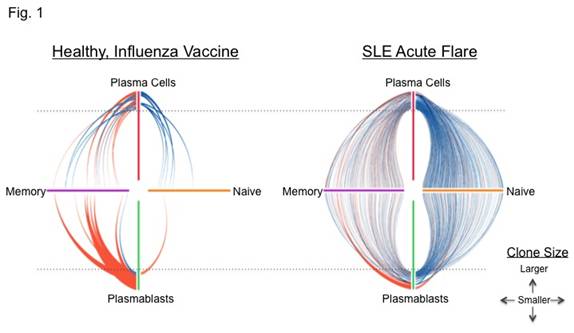Session Information
Session Type: Abstract Submissions (ACR)
Background/Purpose :
Systemic Lupus Erythematosus (SLE) is an autoimmune disease in which faulty B cell tolerance promotes the generation of multiple autoantibodies of which anti-ds DNA, anti-Sm and VH4-34-encoded 9G4 antibodies, are highly specific for this disease. Acute SLE flares are typically accompanied by a substantial expansion of circulating antibody-secreting plasmablasts (PB) and plasma cells (PC). Similar expansions of PB/PC populations in healthy subjects post-immunization are comprised of large clonal expansions of antigen-specific cells derived from pre-existing memory cells. To determine if SLE PB/PC expansions follow the same model, and to understand the diversity, origin and antigenic specificity of SLE PB/PC expansions, we used immunoglobulin heavy chain (IGH) deep sequencing to analyze sorted cells obtained from patients experiencing acute flares.
Methods:
Peripheral blood lymphocytes were sorted into various B cell populations. Multiple VH family-specific primer sets were used to amplify the IGH gene from extracted RNA and then sequenced using the Illumina MiSeq platform. Sequences were analyzed using internally designed analysis software. Our software conducts quality filtering, detailed mutational analysis and identifies inter-population relationships between samples.
Results:
PB/PC expansions in SLE acute flares are a highly diversified repertoire with lower VH mutation rates than memory cells. However, within this diverse pool significant clonal expansions accounting for 0.5% or more of the entire repertoire were regularly detected. Strikingly, VH4-34 sequences comprised the largest clones in all SLE samples. Also of interest, a substantial fraction of PB/PC in SLE were highly evolutionarily related to a pool of activated naïve precursors. This was in stark contrast to results obtained in PB/PC samples from healthy, vaccinated subjects, which contained large, clonal expansions, high VH mutation rates, were largely related to memory cells, and had an absence of autoreactive VH4-34 clonal expansions. Figure 1 shows clonal relationships between the top 20% of PB and PC sequences and Naive and Memory clones. Clones are arranged in increasing size from center to outer edge, and lines link matching clones.
Conclusion:
Combined, our data support a model of generalized naïve and memory activation underlying the activation phase of human SLE. This polyclonal activation is accentuated, and possibly promotes, antigen-selected clonal expansions dominated by VH4-34-encoded autoreactive 9G4 antibodies. Ongoing monoclonal antibody studies will clarify the nature of the selecting antigens.
Disclosure:
C. Tipton,
None;
C. Fucile,
None;
A. Rosenberg,
None;
S. Jenks,
None;
J. Hom,
None;
F. E. H. Lee,
None;
I. Sanz,
Pfizer Inc,
5,
Biogen Idec,
9.
« Back to 2013 ACR/ARHP Annual Meeting
ACR Meeting Abstracts - https://acrabstracts.org/abstract/plasma-cells-in-acute-systemic-lupus-erythematosus-flares-are-characterized-by-a-highly-diversified-repertoire-accentuated-by-clonal-expansions-of-vh4-34-antibodies/

